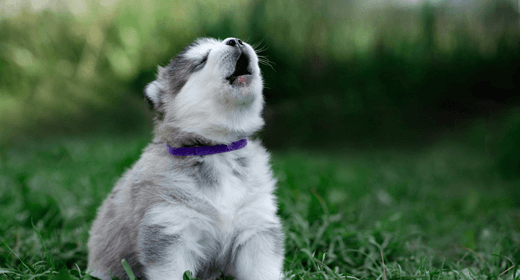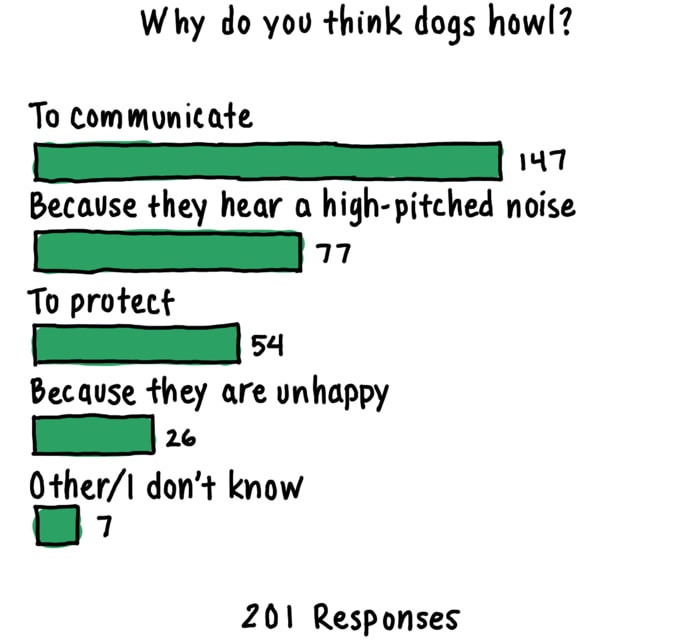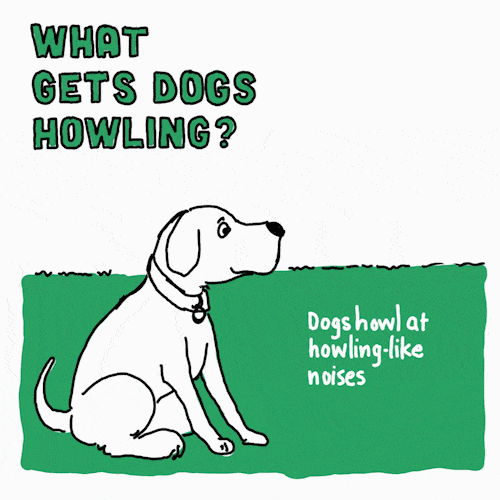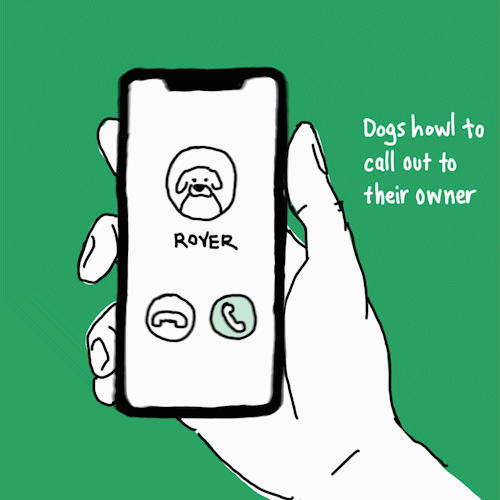

Every pet parent wants to know the meaning of dog howling. Now, we all know what howling sounds like - it’s a high-pitched sound that sounds like a doleful cry. However, many of us are still quite unaware of why do dogs howl. Well, here’s a fun fact: howling for dogs is genetic inheritance. It’s no news that dogs are closely related to wolves. Despite the difference in their sizes, wolves and dogs share around 99% DNA. However, heredity is not the only reason why dogs howl. So, what does it mean when a dog howls, and how can you handle your howling dog? You will find answers to such questions in this article.
To handle a howling dog, you first need to understand the reason why your pet is making this long, wailing noise. Here’s a look at some probable causes of dog howling.
Dogs feel stimulated by high-pitched sounds. Howling is their way of responding to fireworks, sirens, bells, and other noises. This type of howling starts as soon as they hear the shrill sound. As a pet owner, you don’t have to worry about this type of howling since it usually stops when the trigger sound does.
If a dog is excessively attached to you, they might experience separation anxiety. So, once your little companion learns that you won’t be around for a few days, they might start howling under stress and anxiety. If your dog howls every time you need to leave for a long period, it is a sign of hyper-attachment. You might have to treat their anxiety to manage this type of howling. And no, scolding them is not the right way of doing it.
A howling dog could also be seeking attention. And this type of dog howling can be bothersome. You might feel like scolding, questioning, or holding your furball, but you must do the exact opposite of it. Avoid giving your pet any type of attention. Don’t pamper or scold them.
Dogs can sense bad weather, earthquakes, diseases, and so much more. Hence, you cannot rule out the fact that a howling dog could also be trying to alert you of something. Maybe they feel a situation is not right for you or could cause you potential harm. Dogs can sense the intentions of a person through their facial expressions. That’s exactly why dogs howl at some people who try to get near you or your house.
Dogs are still very social animals; it’s just that now we are their pack. When they miss us, they will howl in hopes we respond. Dr. James Serpell, BSc, Ph.D., Professor of Humane Ethics & Animal Welfare at the University of Pennsylvania School of Veterinary Medicine, explains it this way: That [howling] is an attempt on the part of the dog to ask the owner, ‘Where are you so that I can rejoin you?’
Dr. James Serpell doesn’t believe so. “My own research has shown that it is common across breeds. People think huskies may be more prone to group howling.”
Dogs going through separation anxiety may howl excessively when left home alone. Dr. Jo Gale, BVetMed CertLAS MRCVS, Senior Manager for Global Science Advocacy at Waltham Petcare Science Institute, says, “If you reinforce quiet behavior, they are less likely to continue howling.” You can do this by quieting your dog and then leaving for a very brief time before returning and rewarding them when they stay quiet. Gradually increase the time you’re gone to reassure them you’ll always be back.
But what if your pawsome pet is howling due to other reasons? Let’s understand how to handle such situations:
As a pet parent, you must avoid reacting to the howling. This could encourage your dog to howl even more. If you avoid reacting, your dog will understand that howling won’t get their demands met. This might possibly work towards reducing this behaviour in the future.
Pamper your little companion when they do not howl on hearing a siren or bell. Give them attention and love when they are calm to encourage quiet behaviour. Always keep your pet’s favourite treats ready so you can let them know they have been a good boy or good girl by not howling.
If your pooch often reacts to high-pitched sounds, you can even get in touch with a dog trainer. They can work with your dog to change their response to triggering sounds like sirens and fireworks.
Note: Training your fur baby is a time-consuming process. Hence, stay consistent with the actions recommended above and your pet will learn to control their howling triggers.
If you're looking for the perfect dog for you, try our Dog Breed Selector today and enjoy a lifetime of tail-wagging joy.
To understand what a howling dog means to communicate, you need to first read the situation. When dogs howl, it could mean anything–a response to high-pitched sounds, an attempt to attract attention, a suspicion towards someone, etc.
Yes. Since dogs are genetically programmed to howl, it is okay to leave them alone when they do that. However, if it bothers your neighbours, you might want to learn to handle your fur baby or get professional help.
While howling sounds like a long cry, it doesn’t always mean that they are sad.
To stop your dog’s howling, you can reward their calm and quiet behaviour. If they are howling for attention, avoid reacting to it. If you need more help, you may want to reach out to a dog trainer.





Leash training can help your puppy safely explore the world beyond your house or backyard. It can enhance your dog’s walking experience and help you bond with it better. We must remember that dogs are not born with the ability to walk on a leash, they need to be taught. As their caregivers, we need to help them learn this skill comfortably.
If you have a large breed pup, it is imperative that you train it while it is still young. Once your fur baby grows up to be heavy, you will have a tough time handling it on a leash. You do not want to be dragged along the ground or see your dog get into an easily avoidable fracas.
In case you are wondering at what age to start leash training a puppy, here’s your answer: You are start at 10 weeks of its age, however, you must know that it can be done earlier. It will help your pup grow into an obedient pawsome pal. Leash training also makes it easier for you to travel with your pet and embark on exciting adventures seamlessly! Train your puppies while they are still young as it will stay with them for the rest of their lives.
If you are facing any trouble with how to teach your puppy to walk on a leash, here are some tips to get you started:
Picking the right collar is the first step to getting your dog used to a puppy leash. It is imperative that your fur baby feels comfortable in it. So, make sure that the collar is neither too tight nor too loose; there should be space for at least two fingers under it. While leash training your puppy, breathability and comfort is of paramount importance.
Note: If you plan on training your puppy at an early age, stay attentive during sessions. Since your little furry friend will be at a developing stage, it will outgrow its collar soon. Make sure that you keep checking the fit of the collar and change it as and when needed.
Your puppy will need some time to get used to the leash. For puppies, this is an alien thing, and they will need some time to adjust and accept this new accessory. You can help your pup ease into this process by trying a few tricks. It needs to resonate a leash with fun times. Let it spend some time playing with the leash. You can also make your canine companion wear it every time you are having a fun time together at home. Do not put it on when it is alone, sad, or irritated.
As you teach your puppy how to walk on a leash, remember that rewarding it with treats will only promote good behaviour. Grab a treat in your hands and take a few steps back. This will encourage your pooch to walk towards you to devour its favourite treat. To avoid overeating, you can also reward the pup with toys, praises, or belly rubs.
Note: Do not stretch your dog’s leash training for prolonged hours. It might get exhausted and shy away from training.
Indoor practice is the best way of gauging how your canine companion fares with the concept of walking on leash. This will also help you get your puppy used to the leash without losing control of it. Choose a decent stretch of floor in your home, make sure there are no obstructions, and just start walking with your puppy on a leash. At the end of one stretch, reward it with treats. Stay attentive during these session to know when your pup is ready for the world outside your home.
Teaching your puppy how to walk on a leash is going to be full of surprises. If you think that your pet will easily walk on a leash outdoors once it has learnt to do it indoors, you are mistaken. Being curious is only natural and that is exactly what will happen once your four-legged friend realises that it is not at home anymore! Your dog will want to sniff every corner, every plant, and whatever it sets its eyes on. Hence, start with short outdoor walks!
Note: Carry some treats with you to encourage your puppy to follow you!
Remember that patience is key! And your furry friend is not the only one who needs to be patient during this process. Your puppy is going to need some time to get used to this walking style and you need to give it that time. Moreover, make sure that this transition is smooth and comfortable for your pup. Once you start putting these tips into action, you two can start taking long strolls together.